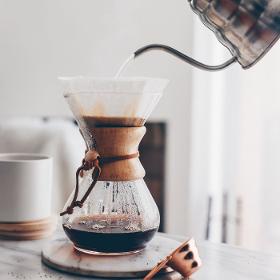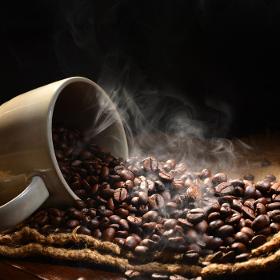- europages
- >
- Coffee and tea
- >
- JACK MACK COFFEE
- >
- products
JACK MACK COFFEE - Fresh roasted coffee beans
Cyprus
Distributor


JACK MACK COFFEE
Cyprus
Coffee beans are the seeds of the coffee plant and come in many different types, each with its unique characteristics. The two most commonly grown species of coffee beans are Arabica and Robusta. Here's a closer look at these two types of coffee beans: Arabica: Arabica beans are considered to be the higher quality of the two main coffee species. They are grown at high altitudes and in cooler climates, which gives them a more complex and nuanced flavor profile. Arabica beans have a lower caffeine content than Robusta beans, which results in a smoother and less bitter taste. Some popular varieties of Arabica beans include Ethiopian, Colombian, and Brazilian. Robusta: Robusta beans are grown at lower altitudes and in warmer climates, resulting in a higher yield per plant. They have a stronger and more bitter taste than Arabica beans and are often used in blends to add depth and crema to espresso drinks. Robusta beans also have a higher caffeine content than Arabica beans.
Request for a quote
JACK MACK COFFEE
Cyprus
Firstly, coffee is rich in antioxidants, which are compounds that help to protect our cells from damage caused by free radicals. These antioxidants can help to reduce the risk of chronic diseases such as cancer, heart disease, and Alzheimer's disease.Additionally, coffee has been shown to improve cognitive function, including memory, attention, and alertness. This is due to its high caffeine content, which stimulates the central nervous system and increases the production of neurotransmitters that are involved in cognitive function.Coffee may also help to lower the risk of type 2 diabetes. Studies have found that drinking coffee on a regular basis can improve insulin sensitivity and reduce the risk of developing type 2 diabetes.In conclusion, coffee can be a beneficial addition to a healthy diet and lifestyle, providing a range of health benefits from antioxidants to improved cognitive function.
Request for a quote
JACK MACK COFFEE
Cyprus
Making a perfect cappuccino can be a bit of an art form, but with the right technique and equipment, anyone can do it. Here's a step-by-step guide to preparing a perfect cappuccino: Use high-quality espresso beans and grind them fresh. Preheat your espresso machine and steam wand. Brew a shot of espresso with a thick and creamy crema. Froth your milk to create a smooth, velvety foam. Pour the frothed milk over the espresso in a circular motion. Spoon some of the foam on top of the cappuccino. And that's it! With a little practice, you'll be able to prepare a perfect cappuccino every time.
Request for a quote
JACK MACK COFFEE
Cyprus
The best drip coffee is a matter of personal preference, but some factors that can affect the taste and quality of drip coffee include the quality of the coffee beans, the grind size, the water temperature, and the brewing time. It's important to use freshly roasted, high-quality beans and to grind them just before brewing. The grind size should be appropriate for drip brewing, which is a medium-coarse grind. The water temperature should be between 195-205°F (90-96°C) and the brewing time should be between 4-6 minutes. Additionally, using a good quality coffee maker with a showerhead or evenly distributed water flow can help to ensure that the coffee is brewed evenly and the flavor is well-developed.
Request for a quote
JACK MACK COFFEE
Cyprus
Both café latte and flat white are popular coffee drinks made with espresso and milk, but they differ in their milk-to-espresso ratio and the texture of the milk used. A café latte typically contains one shot of espresso and is topped with steamed milk and a small layer of foam. The milk-to-espresso ratio is typically 3:1, making it a milder, creamier drink. The texture of the milk used in a latte is typically more frothy and aerated than that of a flat white. A flat white, on the other hand, typically contains two shots of espresso and a smaller amount of steamed milk, resulting in a stronger coffee flavor. The milk-to-espresso ratio is typically 1:3, making it a bolder, more espresso-forward drink. The texture of the milk used in a flat white is typically smoother and silkier than that of a latte. In summary, the main differences between a café latte and a flat white are the amount and texture of the milk used, as well as the strength of the coffee flavor.
Request for a quote
JACK MACK COFFEE
Cyprus
There are several ways to recycle used coffee grounds: Composting: Coffee grounds are high in nitrogen, which makes them an excellent addition to compost. Simply mix them in with other compost materials and let nature do its job. Fertilizer: Coffee grounds can also be used as a natural fertilizer for plants. Sprinkle the coffee grounds around the base of the plants, and they will slowly release nitrogen and other nutrients into the soil. Pest repellent: Coffee grounds can be used to repel pests, such as ants, slugs, and snails. Simply sprinkle the coffee grounds around the areas where the pests are present. Deodorizer: Coffee grounds can absorb unpleasant odors. Place a bowl of used coffee grounds in the fridge, freezer, or any other area that needs deodorizing. Skincare: Coffee grounds can be used as a natural exfoliant for the skin. Mix the grounds with a little bit of oil or water to create a paste, and gently scrub the skin in circular motions.
Request for a quote
JACK MACK COFFEE
Cyprus
The French press, also known as a press pot or plunger pot, is a coffee brewing device that was invented in France in the mid-1800s. The first patent for a French press was filed by a Frenchman named Mayer in 1852. However, it wasn't until the early 20th century that the French press became popular in France and throughout Europe. This was due in part to the rise of coffee culture and the availability of affordable coffee beans. In the 1920s, the French company Melior introduced a glass and metal French press design that became very popular. The design was later improved by Italian designer Attilio Calimani in the 1950s, who added a filter screen to the plunger to prevent coffee grounds from escaping into the cup. Today, the French press remains a popular brewing method around the world, prized for its simplicity, rich and full-bodied coffee, and ability to brew large quantities at once. The French press has become an iconic symbol of coffee culture.
Request for a quote
JACK MACK COFFEE
Cyprus
Cleaning a burr coffee grinder is essential for maintaining its performance and prolonging its lifespan. Here's a step-by-step guide on how to clean a burr coffee grinder: Unplug the grinder: Before starting the cleaning process, make sure to unplug the grinder from the power source to prevent any accidents. Disassemble the grinder: Remove the hopper and the burr from the grinder. Most grinders have a removable burr, which can be easily taken out by twisting it clockwise. Brush the burr: Using a stiff-bristled brush, remove any coffee grounds or debris that have accumulated on the burr. Wash the hopper: If your hopper is removable, wash it with warm, soapy water and rinse it thoroughly. Let it dry completely before reassembling. Reassemble the grinder: Once the burr and hopper are clean and dry, put them back in their respective places. Run the grinder: Turn on the grinder and let it run for a few seconds without any coffee beans to remove any remaining debris.
Request for a quote
JACK MACK COFFEE
Cyprus
There are many coffee origins from around the world that are known for their unique and distinctive flavors. Here are 3 must-taste coffee origins: Ethiopia: Ethiopia is considered to be the birthplace of coffee and is known for its complex and fruity flavors. Ethiopian coffee is often described as having a bright acidity and floral notes. Colombia: Colombia is the second-largest producer of coffee in the world and is known for its mild, balanced, and nutty flavors. Colombian coffee is often described as having a medium body and a bright acidity. Kenya: Kenyan coffee is known for its bright acidity, fruity flavors, and intense aroma. It is often described as having a wine-like taste with notes of berries and citrus.
Request for a quote
JACK MACK COFFEE
Cyprus
Brewing specialty coffee while traveling can be challenging, but it's definitely doable. Here are some tips on how to brew specialty coffee while traveling: Bring your own coffee and equipment: One of the easiest ways to ensure that you can enjoy specialty coffee while traveling is to bring your own coffee and brewing equipment. Pack a travel-friendly brewing method, such as an Aeropress or a pour-over dripper, and bring freshly roasted whole bean coffee. Look for specialty coffee shops: If you don't want to bring your own equipment, look for specialty coffee shops at your destination. Specialty coffee shops often offer a variety of brewing methods and high-quality beans, so you can try new coffees and brewing methods. Check for hotel amenities: Some hotels offer in-room coffee makers or have coffee shops in the lobby. If you're staying at a hotel, check if they have any coffee-related amenities that you can use.
Request for a quoteDistributor
Agapiou Zakka 35
Leptos peyia gardens
8560 Peyia - Cyprus